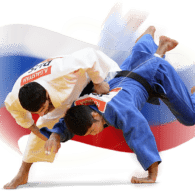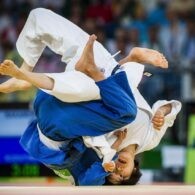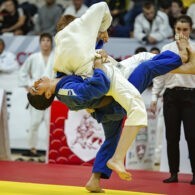«The Way of Gentleness» is a non-violent, primarily martial defensive art created in 1882 by Jigoro Kano (1860 – 1938). Based mainly on hand-to-hand combat techniques used in jujutsu. The word judo itself was used in the Jikishin-ryu school of jujutsu to designate the martial art of this school, which relied on techniques that were not lethal. This term was revived by Kano Jigoro, who wanted to turn jujutsu into a “combat sport” for physical training and general education of youth. He said: “The purpose of judo is to understand and demonstrate the living laws of movement.” For this purpose, Kano Jigoro selected a number of movements of the torso, arms and legs from the arsenal of jujutsu, which were especially effective in hand-to-hand combat. These techniques covered the areas of combat on the ground and in a standing position; Kano Jigoro used variants of these techniques that made it possible to disrupt the opponent’s balance (kuzushi) and immobilize him. The ultimate goal was the ability to neutralize the enemy, so Kano Jigoro created a system of self-defense, which is studied in combination with mastery of the general laws of movement.
To learn judo you need a partner. Further training develops into training in a free fight (randori), in which the opponent, or “submissive” (uke), throws himself onto the mat and is immobilized by the “thrower” (tari). Training and competitions take place in a ju-dojo (or dojo for short), on a floor covered with tatami mats to cushion falls (ukemi).
As in all martial arts, the practitioner of judo (judo-ka) strives to achieve flexibility of the whole body and limbs, speed of body movements (tai-sa6aki) and perfect balance through control of the breath and concentration of energies in the Hara (located in the lower abdomen center). balance and reservoir of internal energy), as well as through careful study of the techniques of one’s art. A spirit of detachment and serenity should reign in judo. The student should try to remain in a state of constant vigilance “hantai”, avoiding “dead movements” (bonno). Armed with a disciplined mind, calm and serene, controlling his body and reactions, the student can easily throw any opponent to the ground. Judo was created at the Tokyo Buddhist temple Eiho-ji in 1882. It developed rapidly, and the first black belt rank was awarded by Kano Jigoro to his student Tairo Shiro as early as 1883. When Kano Jigoro went to Europe in 1889 to teach his technique, there were about 600 students in his dojo. Following a demonstration of the art of judo held in Marseille that same year, the first dojos were founded in France, particularly in Paris. Returning to Japan, the Founder continued his work and in 1922 created the Kodokan, which was to become the official center of the judo movement. Since the late nineteenth century, various Japanese jujutsu instructors have visited Britain. (It was then that the distorted name of this martial art came into use – “jiu-jitsu”). Then the influence of judo began to increase. In 1920, Kano Jigoro visited London and accepted the local judo and jujutsu communities into the Kodokan as overseas branches.
By 1956, judo had become a compulsory sport in all Japanese schools, and for some time the Japanese won all the world championships. But, in 1961, the Dutch giant Anton Gesink defeated the Japanese champion Sone, and since then it became obvious that the advantage was on the side of taller and heavier fighters. Recognition of this fact led to the creation of weight categories in judo, like in boxing . This move was contrary to the entire concept of judo formulated by Kano Jigoro, but in the post-war years Western judo organizations began to view judo more and more as a combat sport and less and less as a way of life. This gradually led to an ideological split between sports-oriented judo-ka and those who continued to adhere to the ideals of the Founder and the traditions of Japanese martial arts. A similar duality can be observed in all martial arts that have left their native shores and taken root in Western countries. The division of wrestlers into weight categories coincided with the 1964 Tokyo Olympic Games. This was partly timely, since the last thing the Japanese wanted was to be completely defeated in their own country. Although Geesink and later his compatriot Ruska dominated the heavyweight category, the Japanese remained champions in other categories at the World Championships. And only in 1969, the Japanese heavyweight Sinomani became the champion, defeating Ruska in Mexico.
Since its debut as an Olympic sport in 1964, judo has changed rules and weight categories several times. The world championships began in 1956 and are held every two years. The first European Judo Championship among men took place in 1951 (it was won by the French team); among women – in 1982. Since 1974, the European Cup has also been held. Kano Jigoro was always strongly opposed to any public competition, since he believed that judo should be a personal art for training the mind and body.
The essence of judo is contained in the oath that students take upon joining the Kodokan:
- Having joined the Kodokan, I will not quit my studies without a good reason. I will not disgrace the Dojo.
- Without permission, I will not reveal to anyone the secrets I have been taught.
- First as a student, then as a teacher, I will always follow the laws of the Dojo.
According to Kano Jigoro, judo is not so much the art of self-defense without weapons, but rather a philosophy, the art of everyday life. “Studying the general principles of judo,” he said, “is more important than just practicing jujutsu.” Unfortunately, in modern judo competitions the spirit of the Founder is felt less and less. They become, in fact, competitions of strength and are more related to the sphere of wrestling than true judo. This is probably why other disciplines, such as aiki-do and karate, have become increasingly popular among martial arts lovers, although karate has also degenerated into a very aggressive competitive martial arts. However, judo is still one of the most widespread sports in the world, practiced by millions. Judo training takes place in several stages. Standing techniques (tachiwaza) and ground fighting techniques (ne-waza) are studied. Each stage of learning is marked by awarding the student a colored belt (obi). The color of the belt corresponds to the level or rank (kyu) achieved. The ranks of black belt and above are called dan. Belts also have a purely utilitarian function: to tighten uniforms (judo-gi).
More details about the history of the emergence and development of Judo can be found in the biography of the Founder, Jigoro Kano.





